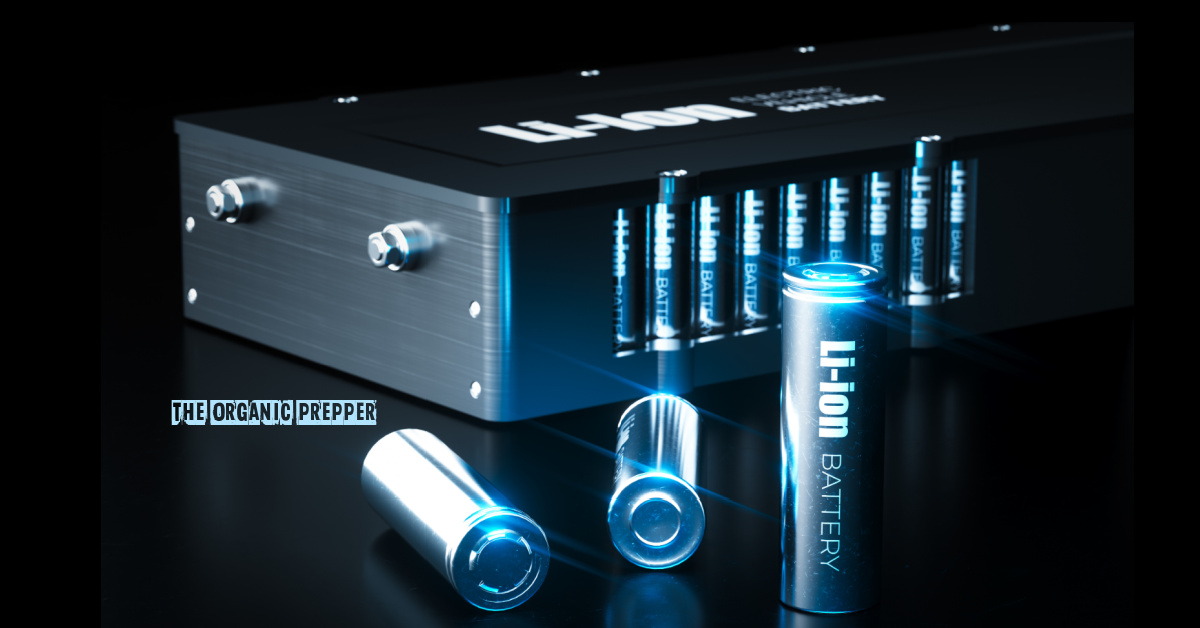(Psst: The FTC wants me to remind you that this website contains affiliate links. That means if you make a purchase from a link you click on, I might receive a small commission. This does not increase the price you’ll pay for that item nor does it decrease the awesomeness of the item. ~ Daisy)
Lithium batteries are the latest revolution in modern life.
It is amazing to see how this technology took over the whole world. They have been such a blast that people used to technical aspects of things, like myself, can’t help but wonder what will happen when the next generation of batteries makes it to the market.
Some batteries in the lithium category include:
- Lithium Cobalt Oxide (LiCoO22)
- Lithium Nickel Manganese Cobalt Oxide (LiNiMnCoO2)
- Lithium Titanate (LTO)
- Lithium Manganese Oxide (LiMn2O4)
- Lithium Nickel Cobalt Aluminum Oxide (LiNiCoAlO2)
All of them with different capabilities and properties and different usages. For instance, to power machines in medical environments, Titanate Oxide is widely accepted. Their self-ignition risk makes them suitable for this particular application.
Don’t get me wrong; when I started to increase my self-reliance, I bought nothing but rechargeable NiCad batteries. I knew this was the way in a country like mine. However, back then, NiCad (Nickel Cadmium) was the most common chemistry. And they are still working. A little less performance than they initially had, but after 15 years, is to be expected. They should have been discarded years ago, but I will use them until they can’t hold a charge anymore.
The thing is, I don’t want to throw them away because heavy metals are very bad for water sources, and we don’t have processing facilities nearby. There is a plant on the opposite side of the country. And it’s not like I have too much to dispose of, indeed.
Since then, lithium batteries have gone from powering our smartphones and laptops to propelling electric vehicles and storing immense amounts of solar energy.
These compact powerhouses provide exceptional energy density and convenience. But behind their brilliance lurks a dark side: the potential for catastrophic failure. I know this firsthand because of my technical background. And some interesting and “classified” experiments with chemistry (ahem).
I watched one of these batteries explode in a coworker’s laptop right on his desk, indeed, back in the early 2000s
For preppers, understanding these hazards is crucial for ensuring the safety and reliability of their critical energy stores.
The allure of lithium-ion
Let’s be honest, batteries are amazing. They liberate us from the constraints of cords and outlets, freeing us to explore, work, and connect wherever we want. Lithium-ion batteries, in particular, shine when it comes to efficiency and capacity at decent temperatures.
Compared to their predecessors, they hold more energy while remaining lightweight and compact, and that makes them perfect for portable electronics and off-grid power systems.
But…”with great power comes great responsibility”
The lurking danger within lithium batteries
Despite their outstanding benefits, lithium batteries aren’t without risks. While uncommon, their potential for overheating and catching fire is a genuine concern.
These fiery infernos can cause all kinds of serious injuries, extensive property damage, and even loss of life.
Unlike traditional fires, lithium-ion blazes are notoriously difficult to extinguish and release highly toxic fumes, adding another layer of danger. That is why you NEED a good respirator mask!!
Here is where the equation “Probability Vs. Consequence” balance has to be carefully addressed. The probability of a battery catching on fire by itself is not very high, but the consequences are usually awful.
The culprits behind the inferno
Several factors can trigger a lithium-ion meltdown:
- Short circuits: When two positive and negative terminals touch inadvertently, an uncontrolled surge of energy can result in rapid heating and potential fire. The contact is not so hard to avoid using common sense, though. This can happen due to internal defects, physical damage (like a puncture!), or incompatible chargers.
- Overcharging: Pushing a battery beyond its capacity strains its internal components, raising the risk of overheating and internal combustion. Most modern batteries have good safeguards, though, but faulty electronics or improper charging practices can override these protections. It is more of a concern for us builders using components bought separately and rigging everything together.
- Overheating: Exposure to extreme temperatures, such as leaving a battery in a hot car or directly under the summer sun, can destabilize its chemistry and ignite its flammable electrolyte. Not so easy to prevent in this country, which makes us think of additional protections like a remote temperature sensor in any enclosed space where these batteries are.
- Physical damage: Punctures, dents, hits, and/or crushing compromise the battery’s integrity, potentially disrupting its internal system and causing a short circuit or uncontrolled release of energy. The ones designed for automotive use are usually a bit more robust. However, with a good, safe location and some planning, this should not be a problem.
Prepping lithium batteries with prudence
As preppers, relying solely on lithium batteries for emergency power comes with inherent risks. However, with proper knowledge and safety measures, you can mitigate these dangers and enjoy their exceptional performance:
- Buy quality: Invest in batteries from reputable manufacturers known for their stringent quality control. While costlier, they’re less likely to be defective and potentially self-combust. This doesn’t necessarily mean more money; it means we have to select our vendors carefully.
- Charge and monitor wisely: Avoid overcharging by using compatible chargers and monitoring the process. Consider smart chargers that automatically cut off when full. DIYers and builders have an obvious edge; we can rig a custom platform for this and will be quite useful to make it as simple or as complex as we need it, and downstream, troubleshooting will be easier. A little like knowing where the buried water pipes run because you laid them out yourself.
- Temperature control: Store batteries in cool, dry spaces. Avoid harsh environments like extreme heat or freezing temperatures. Mind you that if you locate the batteries in a place inside the house where some heat warms them up, it would be a good idea to have a couple of redundant smoke detectors and your gas mask under the bed, just in case.
- Handle with care: Don’t abuse or puncture these batteries. Treat them with respect, and they’ll likely return the favor. They are not exactly made to throw them in the back of a pickup without a protective case.
The fiery aftermath
Should the unthinkable happen and a lithium battery erupts in flames, staying calm and acting swiftly is paramount:
- Evacuate: Immediately move away from the fire and ensure everyone nearby is safely out of harm’s way. Toxic fumes can spread quickly, so prioritize respiratory protection if possible.
- Call for help: Don’t hesitate a bit to dial 911. Lithium-ion fires are complex and require professional intervention.
- Smother the flames (if safe): If the fire is small and contained, use a fire blanket or sand to smother it. Water is ineffective and can worsen the situation.
Safety beyond the firestorm
Lithium batteries, while potentially risky, offer undeniable benefits. By recognizing the dangers, implementing safety measures, and storing them responsibly, preppers can leverage their incredible capabilities without compromising their well-being. Here are some additional tips for minimizing risks:
- Maintain your batteries: Regularly inspect for signs of damage, like swelling, leaking, or discoloration. Dispose of damaged batteries properly, following local regulations.
- Diversify your power sources: While lithium-ion offers convenience, consider alternatives like lead-acid batteries or renewable energy sources like solar panels and wind turbines to create a more resilient and safer power system.
- Stay informed: Keep up-to-date on the latest regulations and safety recommendations for lithium-ion batteries. Manufacturer recalls and industry advancements can inform your storage and usage practices.
By implementing these strategies, preppers can harness the power of lithium-ion batteries while ensuring a safe and secure environment for themselves and their loved ones. Remember, preparedness is about more than just stockpiling supplies; it’s about making informed choices and mitigating potential risks, even those nestled within the seemingly harmless devices that power our lives.
Other Alternatives To Lithium Batteries
With the explosion of new battery technologies, some other options are available and should be considered as well.
Being the most concerning problem of the inherent instability and flammability of Lithium-ion, the logical step is to ponder, what is the closer option.
This is where the LiFePO4 comes into the scene. Check out the article Are LiFePO4 batteries more stable than lithium-ion batteries?
I am going to stay with the facts, and I would say that yes, LiFePO4 batteries are inherently more stable than conventional lithium batteries. This is because the cathode material in LiFePO4 batteries is lithium iron phosphate, which happens to be much less reactive than the commonly used lithium cobalt oxide in lithium-ion batteries.
LiFePO4 batteries have a higher melting point than conventional lithium-ion batteries, which means they are less likely to catch fire or explode if exposed to high temperatures.
Their resistance to overcharging is also greater, which means they are less likely to be damaged if overcharged.
One of the aspects I like the most is that LiFePO4 batteries also have a longer lifespan than conventional lithium-ion batteries under the same usage pattern and operational conditions. This is because the cathode material in LiFePO4 batteries is less prone to chemical degradation.
In general, LiFePO4 batteries are a safer and more reliable option than conventional lithium-ion batteries. They are a good choice for applications where safety is important, such as in the automotive industry or solar power. The cost is very similar, also.
What are your thoughts?
Do you find this article interesting? Will you stick to your lead-acid batteries, the less expensive and more known option now? Do you prefer this lithium-based chemistry or are you a fan of the Edison nickel-iron hydroxide battery like myself?
Let me know what you think!
Be safe, stay tuned, and thanks for your sponsorship!
About Jose
Jose is an upper middle class professional. He is a former worker of the oil state company with a Bachelor’s degree from one of the best national Universities. He has an old but in good shape SUV, a good 150 square meters house in a nice neighborhood, in a small but (formerly) prosperous city with two middle size malls. Jose is a prepper and shares his eyewitness accounts and survival stories from the collapse of his beloved Venezuela. Jose and his younger kid are currently back in Venezuela, after the intention of setting up a new life in another country didn’t go well. The SARSCOV2 re-shaped the labor market and South American economy so he decided to give it a try to homestead in the mountains, and make a living as best as possible. But this time in his own land, and surrounded by family, friends and acquaintances, with all the gear and equipment collected, as the initial plan was.
Follow Jose on YouTube and gain access to his exclusive content on Patreon. Donations: paypal.me/JoseM151
















